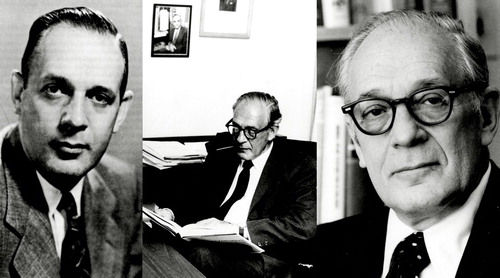Seymour S. Kety, M.D., 1915–2000
Seymour S. Kety, M.D., was born in Philadelphia, Pennsylvania, on August 25, 1915. He received his medical training at the University of Pennsylvania. More than any other single individual, he was responsible for modern psychiatry’s emergence as a rigorous and heuristic branch of medicine that is constantly invigorated by the basic sciences.
In his first major contribution in the neurosciences he developed an original technique for measuring blood flow and energy metabolism in the human brain. This technique was based on his insight that the brain would absorb an inert diffusible gas, via arterial blood, and that the accumulation of the gas within the brain should be independent of the metabolic activity and dependent only on physical parameters such as diffusion, solubility, and perfusion. In a classic paper published in 1948, he presented his comprehensive mathematical treatment of these ideas, which opened new directions in physiology and medicine for exploring blood circulation and metabolism in the human brain (1). With numerous collaborators he examined these processes in normal volunteers and in patients with elevated intracranial pressure, essential hypertension, diabetic acidosis, schizophrenia, and senile dementia, thus elucidating many of the underlying physiological processes. He combined his equations with autoradiography to measure circulation in different regions of the brain of animals. His principles made possible the measurement of local blood flow and the visualization of functional activity throughout the brain. The field of functional brain imaging, thus ushered in, has revolutionized the study of mental, cognitive, and emotional processes and their underlying anatomy and physiology.
In 1950 he became the Scientific Director of the newly established National Institute of Mental Health. There he created a research program of unprecedented magnitude. Recognizing the gap between clinical knowledge of mental illnesses and the inadequate understanding of their biological and psychosocial underpinnings, he organized laboratories in each of the pertinent basic disciplines and recruited the most talented scientists to staff them, with assurances of complete scientific freedom. So successful was his selection, that, among those he appointed, more than 20 were ultimately elected to the National Academy of Sciences.
Between 1959 and 1962 he published incisive critiques of then current methodology, calling for more basic research on the brain and behavior with less targeted research on mental illness (2). To seek a clear indication that schizophrenia had a significant biological substrate, Dr. Kety himself turned to the study of genetics in psychiatric illness. Existing family and twin data tended to confound genetic and environmental influences, but he recognized that adoption could disentangle these factors, and he set about studying the biological and adoptive families of adoptees with schizophrenia (3). These studies, carried out over 25 years with American and Danish colleagues, produced the most definitive evidence to date for the importance of genetic factors in the etiology of schizophrenia.
For these accomplishments, Dr. Kety, who was Professor Emeritus of Neuroscience in the Department of Psychiatry at Harvard Medical School, received the 1999 Albert Lasker Special Achievement Award in Medical Science, the most recent in a series of distinguished honors and prizes. In establishing the foundations of present-day brain research, Kety wove together physiology, chemistry, and morphology in a new understanding of human behavior in health and disease, including the severest of mental diseases, schizophrenia. He truly opened the way to the utilization of basic science for the common welfare of society.
Seymour Kety died May 25, 2000. We will miss him.
Address reprint requests to Dr. Holzman, Department of Psychology, Harvard University, 33 Kirkland St., Cambridge, MA 02138. Photographs, which show Dr. Kety at various stages of his career, were provided courtesy of the American Psychiatric Association Library and Archives.

Seymour SKety, M.D..
1. Kety SS, Schmidt CF: The nitrous oxide method for the quantitative determination.of cerebral blood flow in man: theory, procedure, and normal values. J Clin Invest 1948; 27:484–492Crossref, Medline, Google Scholar
2. Kety SS: Biochemical theories of schizophrenia: a two-partcritical review of current theories and of the evidence used tosupport them. Science 1959; 129:1528–1532, 1590–1596Google Scholar
3. Kety SS, Rosenthal D, Wender PH, Schulsinger F: The types and prevalence of mental illness in the biological and adoptive amilies of adopted schizophrenics, in The Transmission of Schizophrenia. Edited by Rosenthal D, Kety SS. Oxford, UK, Pergamon Press, 1968, pp 345–362Google Scholar



